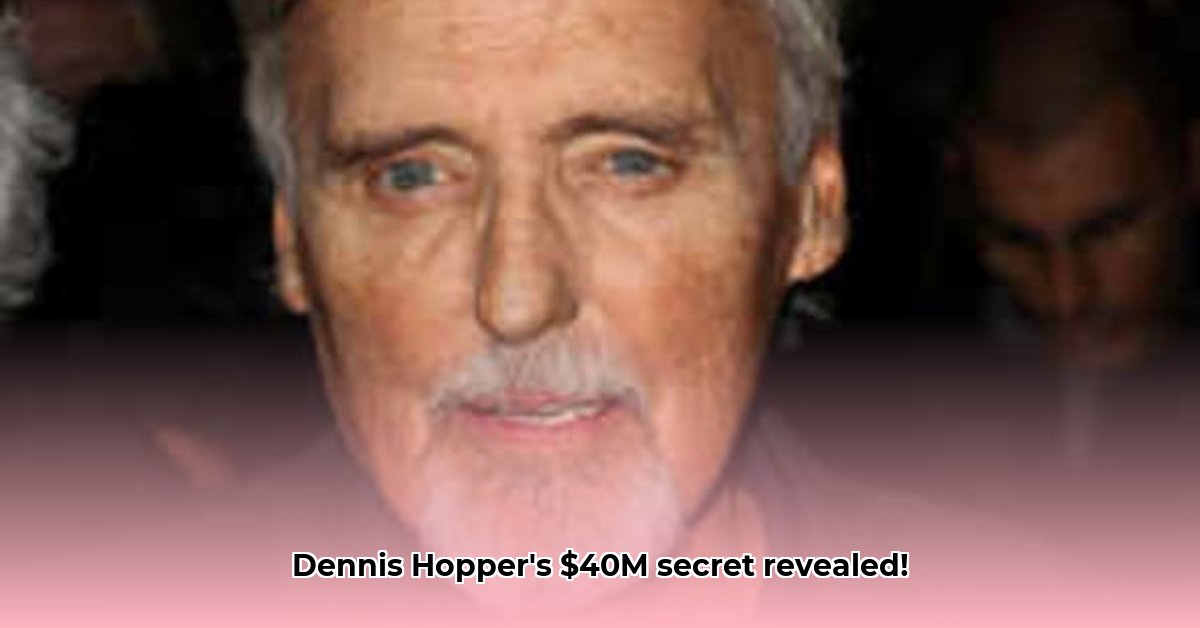
Dennis Hopper's Wild Ride to $40 Million: From Easy Rider to Art Collector
Dennis Hopper. The name conjures images of brooding intensity, leather jackets, and the raw energy of a Hollywood rebel. He was the quintessential anti-hero, a cinematic icon whose life burned as brightly as his iconic roles. But beneath the surface of that rebellious persona lay a surprisingly astute businessman. By the time the curtain fell on his tumultuous life, Hopper had amassed a reported $40 million fortune. This wasn't just luck; it was a carefully orchestrated blend of Hollywood savvy, artistic passion, and some seriously high-stakes gambles.
His early roles, starting with the unforgettable Rebel Without a Cause, provided a solid foundation. These early successes offered financial stability—crucial for an artist forging his own path. Then came the game-changer: Easy Rider. This wasn't just another acting gig; Hopper co-directed, co-wrote, and co-produced this counter-culture landmark. This hands-on approach, a consistent theme throughout his career, reveals his shrewd business acumen. He didn't just ride the wave; he helped create it, securing a substantial piece of the profits. But how substantial? Was it enough to explain his reported $40 million? The answer is multifaceted.
Beyond the silver screen, Hopper’s art collection became legendary. His passion for art, paired with an uncanny ability to spot emerging talent, transformed into a remarkably lucrative investment–an element that significantly boosted his net worth. But his strategies were anything but conventional; they reflected the unpredictable nature of both his personality and the volatile Hollywood landscape. He was a high-roller, embracing significant risks – some might call it genius, others pure recklessness. This willingness to gamble, mirrored in his personal spending habits, shaped his financial trajectory. Was this wild financial approach a stroke of genius or a recipe for disaster? The answer, like his life, is complex.
Hopper's financial journey wasn't a linear climb. His career, like his personal life, experienced periods of breathtaking success punctuated by stretches of financial uncertainty—a stark reminder of the inherently risky nature of the entertainment industry. His fiercely independent spirit – essential to his artistic pursuits – frequently shaped his business decisions. He often prioritized artistic integrity over financial security, turning down lucrative offers to follow his creative muse. This reflects a common challenge for many creative entrepreneurs: the agonizing choice between personal artistic freedom and financial stability.
It’s important to note that the precise value of Hopper's holdings remains elusive. Accurate figures for his art collection, real estate portfolio, and other investments remain partially obscured. While his reported $40 million net worth offers a general idea of his financial success, the full picture remains a captivating mystery. His story isn't just about the money; it's about the thrilling, unpredictable journey of a rebellious artist who played life on his own terms, leaving behind a powerful legacy that goes far beyond any dollar figure.
How Did Dennis Hopper's Art Investments Contribute to His Net Worth?
Key Takeaways:
- Hopper's estimated $40 million net worth resulted from a diversified portfolio, with art playing a significant role.
- He wasn't merely an actor and director; his passion for art transformed into a shrewd investment strategy.
- His art collecting involved calculated risks, strategic moves, and market volatility.
- His approach offers valuable lessons on the art market and investing in art.
- The complexity of his wealth building underscores the unpredictable nature of the entertainment industry.
The Rebellious Collector: A Risk-Taking Visionary
Dennis Hopper wasn’t just a Hollywood icon; he was an art enthusiast intertwined with the vibrant artistic movements of the 1960s and beyond. That intimate involvement shaped his investment strategy. He befriended prominent artists like Andy Warhol and Jasper Johns, gaining insights and access unavailable to most collectors. This unique position, combined with his artistic sensibilities, influenced his collecting choices, leading to a significant portion of his wealth. Did his connections and insight alone explain his success, or were there other factors?
Navigating the Volatile Art Market
Hopper's art investments weren't without risk. The art market ebbs and flows with the unpredictable tides of artistic trends and market sentiment. While some pieces soared in value, rewarding his keen eye and timing, others might not have yielded the expected returns. One could consider this the very essence of high-stakes investing in the art market. Did his risk tolerance correlate with his personality and his unique experiences in the entertainment industry?
Diversification Beyond the Canvas
Hopper’s fortune extended beyond his art collection. He held significant real estate, directing ventures, and acting roles—a diversified portfolio that provided a buffer against the volatile nature of the art market. This strategic approach, crucial to any robust investment strategy, further solidified his financial position. Considering the diverse sources of his wealth, how much did each element contribute to his final net worth?
A Lasting Legacy
Hopper's art collection exceeded mere financial value; it became a reflection of his artistic vision and a lasting legacy. The sale of these pieces after his death generated substantial revenue, further enhancing his overall net worth. But beyond the monetary value, what does his collection represent to the world of art? What is Hopper's lasting contribution to the field of art?